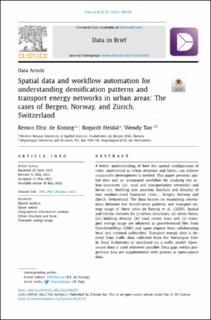| dc.contributor.author | de Koning, Remco Elric | |
| dc.contributor.author | Heldal, Rogardt | |
| dc.contributor.author | Tan, Wendy | |
| dc.date.accessioned | 2022-09-09T10:59:09Z | |
| dc.date.available | 2022-09-09T10:59:09Z | |
| dc.date.created | 2022-05-31T11:16:39Z | |
| dc.date.issued | 2022 | |
| dc.identifier.citation | de Koning, R. E., Heldal, R., & Tan, W. (2022). Spatial data and workflow automation for understanding densification patterns and transport energy networks in urban areas: The cases of Bergen, Norway, and Zürich, Switzerland. Data in Brief, 42. | en_US |
| dc.identifier.issn | 2352-3409 | |
| dc.identifier.uri | https://hdl.handle.net/11250/3016850 | |
| dc.description.abstract | A better understanding of how the spatial configuration of cities, understood as urban structure and forms, can achieve sustainable development is needed. This paper presents spatial data and an automated workflow for studying the urban structures (i.e., road and transportation networks) and forms (i.e., building size, position, function and density) of two medium-sized European cities - Bergen, Norway and Zürich, Switzerland. The data focuses on examining correlations between the densification patterns and transport energy usage of these cities de Koning et al., (2020). Spatial and tabular datasets for (i) urban structures, (ii) urban forms, (iii) building density, (iv) road centre lines and (v) transport energy usage are obtained as georeferenced files from OpenStreetMap (OSM) and upon request from collaborating local and national authorities. Transport energy data is derived from traffic data collected from the Norwegian Public Road Authorities or simulated via a traffic model. Open-source data is used wherever possible. Data gaps within proprietary data are supplemented with proxies or open-source data. Hand-drawn axial maps drawn by the authors using the Space Syntax methods and analysed via depthmapX software are a crucial dataset presented here. All analysed data are then returned to a Geographical Information System (GIS) platform and processed via an automated workflow of 19 steps built via the ModelBuilderTM tool in ESRI® ArcGIS. The automated workflow allows for repetitive cross-city comparison and the compilation of diverse spatial data sources for analysis. In combination with the novel workflow, the dataset can be used for future comparative studies in spatial planning, transport planning and management of energy systems to facilitate informed decision-making towards more sustainable developments. | en_US |
| dc.language.iso | eng | en_US |
| dc.publisher | Elsevier | en_US |
| dc.rights | Navngivelse 4.0 Internasjonal | * |
| dc.rights.uri | http://creativecommons.org/licenses/by/4.0/deed.no | * |
| dc.title | Spatial data and workflow automation for understanding densification patterns and transport energy networks in urban areas: The cases of Bergen, Norway, and Zürich, Switzerland | en_US |
| dc.type | Peer reviewed | en_US |
| dc.type | Journal article | en_US |
| dc.description.version | publishedVersion | en_US |
| dc.rights.holder | © 2022 The Authors | en_US |
| dc.source.pagenumber | 37 | en_US |
| dc.source.volume | 42 | en_US |
| dc.source.journal | Data in Brief | en_US |
| dc.identifier.doi | 10.1016/j.dib.2022.108290 | |
| dc.identifier.cristin | 2028336 | |
| cristin.ispublished | true | |
| cristin.fulltext | original | |
| cristin.qualitycode | 1 | |

